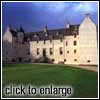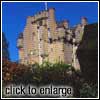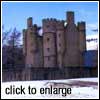|
Aberdeen to Braemar (A93)
Aberdeen and Grampian Tourist Board have denoted several
theme trails to help tourists pursue certain interests and Royal Deeside neatly combines
two of these, the Castle Trail and the Victorian Heritage Trail. It was Queen Victoria,
once again, who popularised this part of Grampian, much to the surprise of other
royalty and aristocracy who were more in favour of warmer climes with less rainfall.
But Queen Victoria and her consort, Prince Albert,
were deeply taken with the rugged, refreshing terrain and the purposeful pace of
life. The royal presence persists to this day, helping to bring this bountiful stretch
of the River Dee the fame it enjoys as well as preserving its natural beauty and
the orderliness of its Victorian villages.
 The first stop on this part of the Castle Trail is Drum Castle
just beyond Peterculter. Built in the thirteenth century, it combines a medieval
keep and a Jacobean mansion house with a Victorian extension. The old keep, dating
from 1290, is one of the three oldest towers in Scotland. The first stop on this part of the Castle Trail is Drum Castle
just beyond Peterculter. Built in the thirteenth century, it combines a medieval
keep and a Jacobean mansion house with a Victorian extension. The old keep, dating
from 1290, is one of the three oldest towers in Scotland.
Set in the Forest of Drum with some splendid oak and
pine trees, the castle originally was a royal hunting seat of Robert the Bruce who
then bequeathed it to his Standard Bearer, William de Irvine, for his services at
the Battle of Bannockburn. It remained in that family for twenty-four generations
until it was passed to the National Trust for Scotland in 1976.
The interior of the seventeenth century mansion is
mainly Victorian with its library extending into the middle level of the old tower,
which is otherwise, uninhabited. There is a pleasant arboretum and walled garden
of historic roses in which to stroll.
 Only 4 miles (6km) down the A93 is Crathes Castle with its
rather special gardens. The castle you see today has seen many changes since the
original sixteenth century granite tower house, but is still a fine example of a
Scottish tower house that reflects the power of the family who lived in it for over
350 years. Only 4 miles (6km) down the A93 is Crathes Castle with its
rather special gardens. The castle you see today has seen many changes since the
original sixteenth century granite tower house, but is still a fine example of a
Scottish tower house that reflects the power of the family who lived in it for over
350 years.
The Burnetts of Leys were also supporters of Robert
the Bruce who gave them the land along with the Horn of Leys, a symbol of their position
that still hangs on the wall of the main hall. Made of ivory, banded in gilt and
set with semi-precious stones, this is also the central symbol on their coat of arms.
The interior of the castle displays items from a wide
period starting from the first laird to the present family. Painted ceilings in the
upper rooms such as the room of the Nine Nobles are a fascinating decorative style
featuring great heroes of the past such as Julius Caesar, King David and King Arthur.
The Long Gallery runs the width of the castle with a ceiling of Scandinavian Oak.
There is a legend of the ghost of the Green Lady,
still reported to be haunting the castle, in particular the Green Lady's Room where
she has been seen with a small baby in her arms. The skeleton of a baby was discovered
beneath the floorboards during the nineteenth century and a story is handed down
that a young woman under the laird's protection mysteriously disappeared after becoming
pregnant by one of the servants.
The delightful gardens are as much a part of Crathes
as the castle. Crathes Gardens are a creation of the twentieth century when Lady
Cybil Burnett designed them with eight separate interlocking enclosures, each with
a theme such as the Colour Garden or the Camel Garden. The splendid yew hedges date
from 1702, indicating the previous existence of a formal garden. Crathes is set in
a large estate with 7 miles (11km) of forest walks.
The A93 leads west, ever deeper into a promising landscape
of silver birches, Scots pines and heather-clad hills. The respectable holiday town
of Banchory sports elegant buildings with a gorgeous pink tinge to their granite.
The River Dee is a main attraction, both visually
and for the salmon and trout fishing it offers although salmon beats on this stretch
of the Dee are notoriously expensive. Trout fishing is much more affordable on the
River Feugh. At the Bridge of Feugh just south of town, there is a rocky channel
where salmon boldly leap (where many have gone before) to reach their spawning grounds.
Banchory Golf Club is sandwiched between the town
and the river, a short but demanding course laid out in sumptuous surroundings. Banchory
Museum tells the history of the area and the tourist office, a cabin in the main
car park, can help find accommodation.
If you have resisted visiting Deeside's castles until
now there is one you should not. Climb the A980 out of Banchory towards a lonely,
fairy tale fortress that overlooks the rolling Grampian hills and valleys. As one
of the most captivating castles in Scotland, Craigievar is ever busy, so much so
that the National Trust for Scotland has taken to omitting it from their leaflets.
Craigievar's sandy, pink facing and ornamental battlements
remain relatively unchanged since they were first built in the sixteenth century.
A local entrepreneur, William Forbes (better known as 'Danzig Willie') who had made
his fortune trading with Scandinavia and the Baltic, decided to leave his mark in
the time honoured manner and built himself a castle. Started in 1626, his edifice
took shape and turned out to be the crowning accomplishment of local masons. It has
its defensive features, the small, single entrance, no windows at ground level and
battlements around the top, although these were ornamental. Otherwise it is a traditional
Scottish tower house in its original form that has stood the rigours of civil war
and the baleful Victorian trend to embellish such fine old buildings.
 Inside you find a welcoming and intimate Scottish retreat
with a genuine 'lived-in' appeal. Its heart is the great hall with a splendid moulded
ceiling of intense intricacy that extends down the walls above the fireplace. There
is no electric light even yet in the castle and the white plasterworkboard along
the walls and ceilings helped to lighten the wood panelled rooms. There are short
walks through the wooded grounds with some fruitful chestnut trees bearing copious
'conkers' in the autumn. Inside you find a welcoming and intimate Scottish retreat
with a genuine 'lived-in' appeal. Its heart is the great hall with a splendid moulded
ceiling of intense intricacy that extends down the walls above the fireplace. There
is no electric light even yet in the castle and the white plasterworkboard along
the walls and ceilings helped to lighten the wood panelled rooms. There are short
walks through the wooded grounds with some fruitful chestnut trees bearing copious
'conkers' in the autumn.
Returning to the main Deeside route via the B9119
you pass through the village of Tarland with its Culsh Earth House, a well-preserved
souterrain and a stone circle at Tomnaverie. South is the community of Aboyne, well
known for its traditional Highland Gathering held every year in September and a fairly
good, though quiet, central base from which to explore Deeside. Both these towns
have good golf courses.
Ballater and Balmoral
Ballater, 11 miles (18km) west of Aboyne, was the
end of the line for the royal train before that railway closed. The coming of the
railway to Deeside in 1867 increased its popularity and Queen Victoria travelled
regularly by royal train from Windsor.
Ballater Station was rebuilt to incorporate a 'Royal
Waiting Room' but today the station is taken over by a wool shop, cafe and the royal
waiting room is now council offices.
Craigievar Castle
 Craigievar's sandy, pink facing and ornamental battlements
remain relatively unchanged since they were first built in the sixteenth century.
A local entrepreneur, William Forbes (better known as 'Danzig Willie') who had made
his fortune trading with Scandinavia and the baltic, decided to leave his mark in
the time honoured manner, and built himself a castle. Craigievar's sandy, pink facing and ornamental battlements
remain relatively unchanged since they were first built in the sixteenth century.
A local entrepreneur, William Forbes (better known as 'Danzig Willie') who had made
his fortune trading with Scandinavia and the baltic, decided to leave his mark in
the time honoured manner, and built himself a castle.
Started in 1626, his edifice took shape and turned
out to be the crowning accomplishment of local masons. It has its defensive features,
the small, single entrance, no windows at ground level and battlements around the
top, although these were ornamental. Otherwise it is a traditional Scottish tower
house in its original form, that has stood the rigours of civil war and the baleful
Victorian trend to embellish such fine old buildings.
Inside you find a welcoming and intimate Scottish
retreat with a genuine 'lived-in' appeal. Its heart is the great hall with a splendid
moulded ceiling of intense intricacy that extends down the walls above the fireplace.
There is no electric light even yet in the castle and the white plasterwork board
along the walls and ceilings helped to lighten the wood panelled rooms. There are
short walks through the wooded grounds with some fruitful chestnut trees bearing
copious 'conkers' in the autumn.
Ballater first became established in the nineteenth
century when an old woman discovered the healing powers of a bog at the foot of Pannanich
Hill. Now it is visited for its close location to Balmoral Castle, which is only
about 8 miles (13km) to the west. In town there are signs of 'royal appointment'
above many of the shops and the Royals do drop in occasionally during their yearly
summer vacation. There is a Victoria Week held every year in early August of which
its highlight is the Highland Games.
Despite the 'tourist clamour' to soak up a piece of
'Balmorality' there are many other things to do in this area. Ballater golf course
is one of the most charming, the surrounding hills protecting it from bad weather
and creating a microclimate for the course and town. Forty miles (64km) away in Aberdeen
it can be chucking it down while Ballater is bone dry.
Making Treks is a shop opposite Ballater Station organising
anything from pigeon shooting to quad-bikes and gliding trips.
Ballater is also a great place to dine. Per head of
population there are more good eating-houses than anywhere else in Britain. The Glen
Lui Hotel has a fine restaurant but the meals in the Bistro, at bar prices are as
edible as in the restaurant and you get a lot more on your plate. The Green Inn on
Golf Road is a well-classed establishment with a good chef while more upmarket are
the Daroch Laird and Balgonie Hotels.
Balmoral Castle and its grounds are open to the public
through the months of May, June and July, Monday to Saturday, 10am-5pm, unless members
of the Royal family are in residence although this is usually confined to the month
of August.
This was the sanctuary of Queen Victoria and Prince
Albert who had it built on the site of an older castle, commenced in 1853 and completed
by 1855. The Royals on the advice of the Queen's physician had leased the original
castle and they instantly fell in love with the area. Unfortunately it was Prince
Albert whose health failed and he died at the age of 40 with typhoid fever. He only
enjoyed seven summers at their beloved castle and hide-away.
Balmoral has been the much-loved Highland home of
succeeding monarchs ever since. A visit to the castle can be a bit of a let-down
with only the ballroom and grounds open to the public along with a refreshment room
and gift shop, although there is pony-trekking and pony-cart rides available.
But Balmoral is surrounded by some extraordinary countryside,
well preserved due to the royal patronage. The fragment of primeval forest at Ballochbue,
for instance, would have been felled if not for the intervention of Queen Victoria
when she bought it in 1878. The Balmoral Estate fronts the south side of the River
Dee for 12 miles (19km) and stretches back over to Lochnagar.
For rugged grandeur there is little to beat Lochnagar
and the 6,350 acres (2,540 hectare) Glen Muick (pronounced Mick) and Lochnagar Wildlife
Reserve which is accessed from Ballater via the Bridge of Muick. This was Queen Victoria's
favourite part of the estate and she built the 'Gras alt Shiel', later known as the
Widow's House.
John Brown, the son of a Crathes small farmer, began
at Balmoral as a stable lad, became a gillie and then a great favourite of the Queen
and Prince Albert.
Royal Lochnagar Distillery on the south side of the
Dee behind the Balmoral Estate was established by John Begg in 1845 and Queen Victoria
was invited to visit in 1848. The royal party sampled the dram and duly placed a
royal Warrant of Appointment as supplier to Queen on his produce. There is a free
guided tour and complimentary dram.
Crathie Church stands across the River Dee near the
entrance to the Balmoral Estate. Queen Victoria opened this lonely little kirk perched
on a knoll above the road in 1895. It then cost £6,000, which was raised by
private donations. The Royal Family attends services in the kirk when staying at
Balmoral.
Braemar
 Despite its proximity to Balmoral, Braemar has a life of its
own and is a delightful little village to stroll around. A mile or so before the
village is Braemar Castle, a seventeenth century turreted outpost. Opposite the castle
is an easy climb that affords a wonderful view of the village and the surrounding
hills. Despite its proximity to Balmoral, Braemar has a life of its
own and is a delightful little village to stroll around. A mile or so before the
village is Braemar Castle, a seventeenth century turreted outpost. Opposite the castle
is an easy climb that affords a wonderful view of the village and the surrounding
hills.
In town, the Invercauld Arms Hotel stands on the spot
where the Earl of Mar raised the Jacobite standard in 1715, and there is a plaque
inside to commemorate this event. The Clunie Water clatters through the village and
under a road bridge that offers invigorating views from both sides. The most important
event to take place in the area is the Braemar Royal Highland Gathering held on the
first Saturday in September with upwards of 50,000 people in attendance. It is a
well-run affair despite the numbers, with traditional events and the eventual arrival
of the royal party.
 Twelve miles (19km) beyond Braemar is the Linn of Dee, a famous
beauty spot where the River Dee is forced through a narrow chasm in the rocks then
under a bridge. The scenery enjoyed on the drive up to the Linn o' Dee is perhaps
even more splendid. There are many fine walks and mountain bike trails up to the
White Bridge and Mar Lodge. The road goes no further west than here so, from Braemar,
it is possible to return to the south via Glen Shee. Twelve miles (19km) beyond Braemar is the Linn of Dee, a famous
beauty spot where the River Dee is forced through a narrow chasm in the rocks then
under a bridge. The scenery enjoyed on the drive up to the Linn o' Dee is perhaps
even more splendid. There are many fine walks and mountain bike trails up to the
White Bridge and Mar Lodge. The road goes no further west than here so, from Braemar,
it is possible to return to the south via Glen Shee.
Glen Shee Ski Centre operates Scotland's largest lift
system, part of which is open throughout the summer, offering wonderful views of
the three valleys and four mountains that the centre is built on.
Further south on the A93 is Blairgowrie and Perth
and the main routes leading to Scotland's central belt. Alternatively strike north
from Braemar via Tomintoul, one of the highest villages in the Highlands at 1,150ft
(351m) above sea level, to Grantown-on-Spey, a particularly dramatic drive.
|






